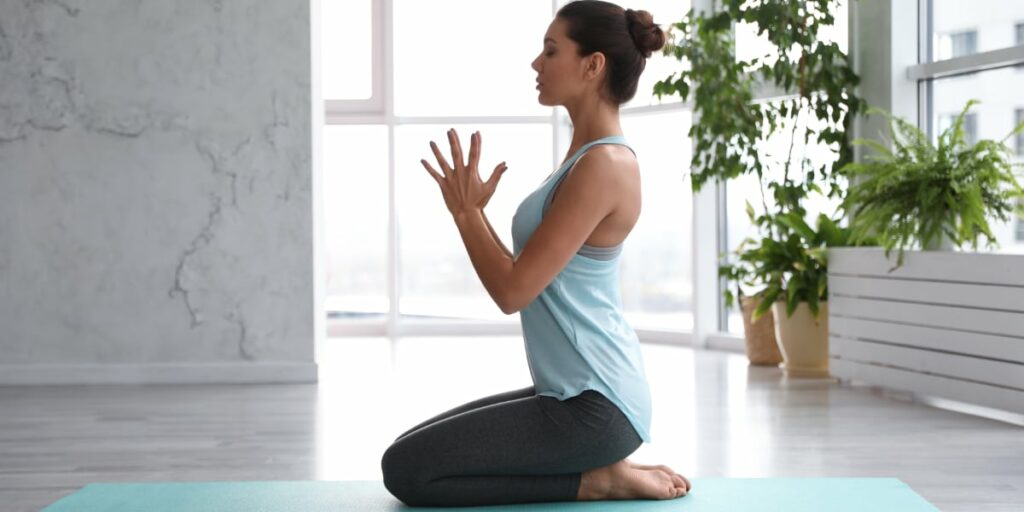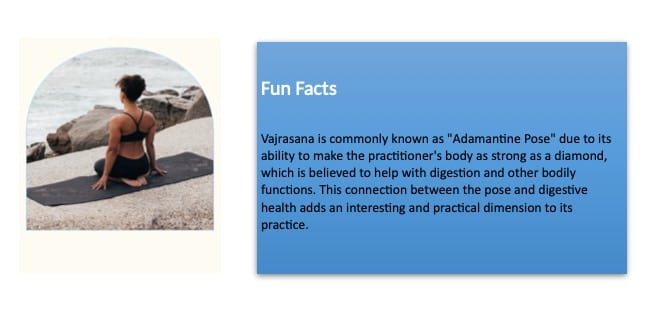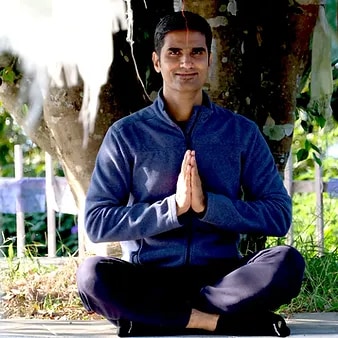Vajrasana: The Thunderbolt Pose
by Hardik Mehta
Vajrasana, often known as the thunderbolt Pose, is a simple yet powerful yoga posture that resembles the stability and strength of a thunderbolt. In this pose, you kneel, sitting back on your heels with your spine erect and your hands resting on your thighs. Like a thunderbolt grounding itself, Vajrasana helps ground your body and mind, offering numerous physical and mental benefits.

Vajrasana and its significance in yoga practice
Sanskrit Name: Vajrasana (वज्रासन)
English Name: Rock-solid Pose/ Thunderbolt Pose
Vajrasana is revered for its significance in yoga practice for several reasons:
Digestive Aid: Vajrasana is considered one of the best postures to aid digestion. By sitting in this pose after meals, you can enhance the digestive process, prevent acidity, and reduce bloating.
Meditation Foundation: Vajrasana is an ideal posture for meditation. Its stable and grounded nature helps you achieve a calm and focused mind, making it easier to enter deeper states of meditation.
Posture Improvement: Regular practice of Vajrasana can improve your posture by strengthening the back and thigh muscles. It also helps alleviate lower back pain and corrects spinal misalignments.
Spiritual Connection: In yoga philosophy, Vajrasana is associated with the concept of grounding and connecting with the Earth’s energy. It symbolizes steadfastness and unwavering commitment to one’s yoga practice.
Versatility: Vajrasana serves as a base for various other yoga poses and practices, making it a versatile and essential asana in yoga.
How to perform Vajrasana
Here are step-by-step instructions on how to get into Vajrasana, the Thunderbolt Pose:
Step 1: Start by kneeling on the floor with your knees together. Your feet should be flat on the ground, and your big toes should touch each other.
Step 2: Sit back on your heels. Ensure that your heels are on the outside of your hips, with your buttocks resting on your heels. Your weight should be evenly distributed between your heels and your sitting bones.
Step 3: Keep your spine straight. Engage your core muscles to support your lower back and avoid slouching or rounding your back.
Step 4: Place your hands on your thighs, palms facing down. You can rest your hands lightly on your thighs or let them rest with your fingers pointing toward your knees.
Step 5: Gently close your eyes, if comfortable, and take slow, deep breaths. Focus on your breath and try to relax in this seated position.
Step 6 (Optional): If you find it uncomfortable to sit directly on your heels, you can place a cushion or folded yoga mat between your buttocks and your heels for added comfort.
Step 7: Hold this pose for as long as you are comfortable. Beginners may start with a few seconds and gradually increase the duration as they become more accustomed to the posture.
Step 8: To release Vajrasana, slowly lift your buttocks off your heels, return to a kneeling position, and then extend your legs in front of you to stretch them.

Important Tips:
- If you have knee or ankle issues, consult a yoga instructor or healthcare professional before attempting Vajrasana, as it can put strain on these joints.
- It is essential to listen to your body. If you feel any pain or discomfort, especially in your knees or ankles, come out of the pose immediately.
- Regular practice of Vajrasana can help improve your flexibility and comfort in this posture over time.
- Remember that yoga is about the journey and progress, so be patient with yourself as you work on your Vajrasana practice.
The importance of proper posture and alignment
The importance of proper posture and alignment in Vajrasana cannot be overstated as it:
- Supports optimal spinal health, preventing back issues and promoting good posture
- Ensures balanced weight distribution, reducing strain on the knees and ankles
- Enhances the flow of energy within the body, facilitating physical and mental well-being in yoga practice
- Physical benefits
- Improved digestion and metabolism
- Strengthening of the back and thighs
- Relief from sciatica and lower back pain
- Mental and spiritual benefits
- Enhanced focus and concentration
- Calming effect on the mind
- Preparation for meditation
Vajrasana and Meditation
The connection between a stable posture and a focused mind is profound. When the body is comfortable and well-supported, it requires less attention and distraction. This allows the meditator to direct their focus inward, towards their breath, mantra, or chosen point of meditation. A stable posture not only reduces physical discomfort but also creates a foundation for mental stillness and concentration. As the body remains motionless and grounded, it becomes easier to quiet the mind, letting go of external distractions and achieving a deeper state of meditation. Thus, Vajrasana serves as a valuable tool for those seeking a serene and undistracted meditation practice
What our Co-founder, Hardik Mehta, has to say about his experience with Vajrasana
The stability and comfort this pose provides are truly remarkable. It has not only relieved me of the physical discomfort that used to distract me but has also given me a strong foundation for my meditation practice. The alignment and posture benefits are evident, and I have found myself sitting with a straighter spine and a more relaxed body, allowing me to delve deeper into meditation with each session.
Precautions to Consider
However, there are some contraindications to consider before practicing Vajrasana:
Knee or Ankle Issues: People with knee or ankle problems, injuries, or pain should avoid Vajrasana or use props like a cushion or yoga block to reduce strain on these joints.
Serious Digestive Issues: Individuals with severe digestive disorders such as ulcers, hernias, or inflammatory bowel diseases should avoid Vajrasana, as it can exacerbate discomfort and pain.
Pregnancy: Pregnant women should avoid practicing Vajrasana, especially in the later stages of pregnancy, as it can put pressure on the abdomen and uterus. It is advisable to consult a healthcare provider before attempting any yoga poses during pregnancy.
Cardiovascular Problems: People with severe heart conditions, hypertension, or other cardiovascular problems should exercise caution while performing Vajrasana, as it can affect blood circulation in the legs and lead to dizziness.
Joint Issues: Those with joint problems, such as arthritis, should be careful when practicing Vajrasana, as it involves sitting on the heels and can put strain on the knees and ankles.
Recent Surgical Procedures: If you have recently undergone surgery in the abdominal or lower body area, it is best to avoid Vajrasana until you have fully healed and received clearance from your healthcare provider.
Always consult with a qualified yoga instructor or healthcare provider if you have any doubts or specific health concerns before attempting any yoga poses, including Vajrasana. They can provide guidance and suggest modifications or alternative poses that are better suited to your individual needs and limitations.
Discover the posture for inner peace and serenity as you watch the enlightening Vajrasana demonstration in the video below.
About the Author

Hardik Mehta
Hardik is an E-RYT 500 & YACEP (Yoga Alliance Continuing Education Provider), Yoga Alliance, USA. He has been practicing yoga for the last 9 years. Prior to finding his true calling in Yoga, he was working with various corporates for 12 years in the Retail and eCommerce sector.
